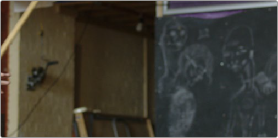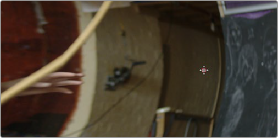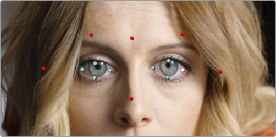

< Previous | Contents | Next >
— Angle: Adjusts the direction and intensity of the warp effect; setting Angle below 0 twists the image to the left, while raising Angle over 0 twists the image to the right.
— Power: Rotates the area that’s affected to create a harder border between what is warped and what isn’t.
— Swirl: Intensifies the effect, twisting the image into an even tighter swirling effect.
— Edge Behavior: The options available in this pop-up eliminate blanking caused by negative distortion by filling black areas in one of several user-defined ways; options include Black (do nothing and leave the blanking), Reflect, Wrap-Around, and Replicate.
Warper (Studio Version Only)
The Warper is a free-form image warper that uses points, rather than a mesh or splines, to push and stretch features in an image as if they were on a sheet of rubber. While the Warper has a lot of options and settings, getting started is really easy.
To warp a feature of the image, just click on it to add a warp point, and drag to push that part of the image in the direction you want it to go. By default, warp points influence the entire image, which is pinned down at the corners. This system makes it simple to warp large regions of the image, such as when you want to warp an edge of the image to get rid of a boom dip. Warp points are gray unless they’re selected, in which case they’re white.


(Left) The original image (Right) The image warped with a single control point
![]()
To “pin down” parts of the image you don’t want to warp, Shift-click to place limiter points (which are red, pink if they’re selected). By combining warp points with limiter points, you can quickly create extremely specific warp effects to squish and stretch features in an image in any way you want.


(Left) The original image (Right) The image warped with control (gray) and limiter (red) points
As you work, you can Option-click any unwanted warp or limiter point to delete it. To start from scratch, you can click the Warper plugin’s master reset control in the OpenFX Inspector.